Financial Accounting Theory and Practice: New Lease Standard Analysis
VerifiedAdded on 2020/04/29
|8
|2185
|140
Report
AI Summary
This report delves into the complexities of the new lease standard, contrasting it with the existing IAS 17. It explores the significant shift in accounting practices, particularly the elimination of the distinction between operating and finance leases, and the subsequent requirement to represent all lease transactions on the balance sheet. The study meticulously examines the potential consequences for companies adopting IFRS, including impacts on financial ratios and balance sheets. The report also highlights the criticisms leveled against the new standard, such as increased administrative burdens, concerns about financial ratio deterioration, and potential impacts on creditworthiness. Furthermore, it analyzes the preparations made by companies in response to these changes, providing a comprehensive overview of the challenges and adaptations within the financial accounting landscape. The report draws on various academic sources to support its analysis and provide a balanced perspective on this evolving area of financial reporting.
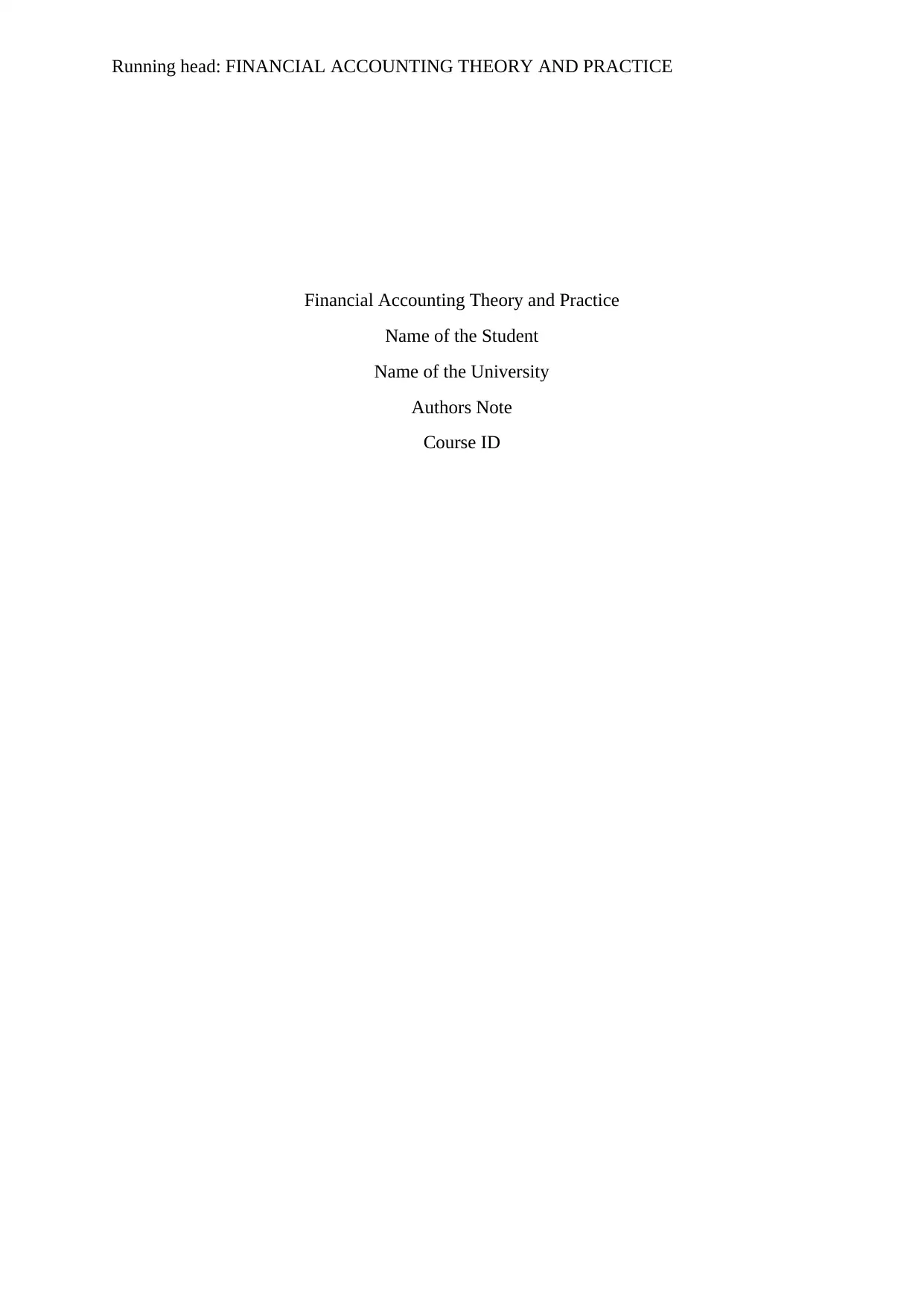
Running head: FINANCIAL ACCOUNTING THEORY AND PRACTICE
Financial Accounting Theory and Practice
Name of the Student
Name of the University
Authors Note
Course ID
Financial Accounting Theory and Practice
Name of the Student
Name of the University
Authors Note
Course ID
Paraphrase This Document
Need a fresh take? Get an instant paraphrase of this document with our AI Paraphraser
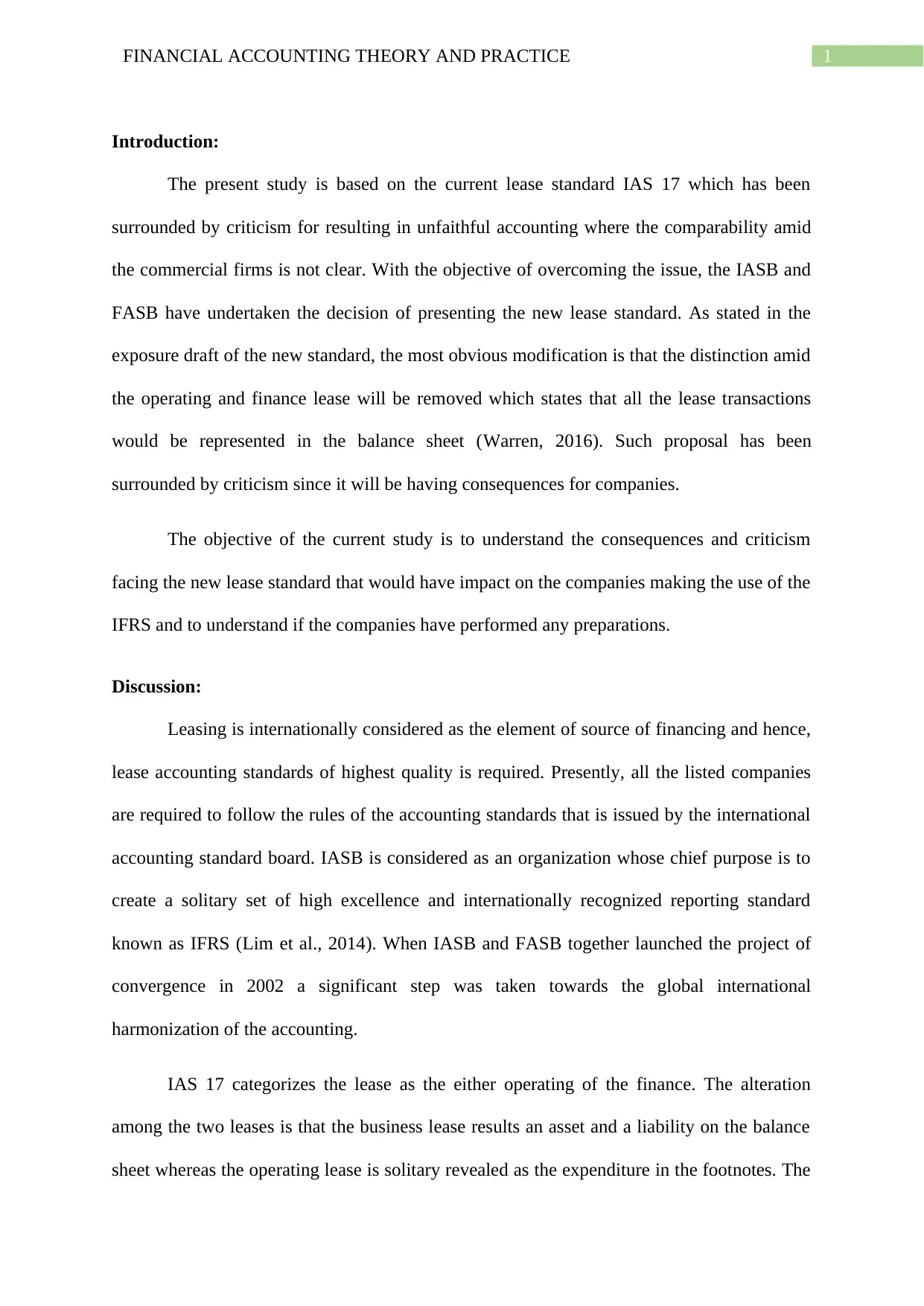
1FINANCIAL ACCOUNTING THEORY AND PRACTICE
Introduction:
The present study is based on the current lease standard IAS 17 which has been
surrounded by criticism for resulting in unfaithful accounting where the comparability amid
the commercial firms is not clear. With the objective of overcoming the issue, the IASB and
FASB have undertaken the decision of presenting the new lease standard. As stated in the
exposure draft of the new standard, the most obvious modification is that the distinction amid
the operating and finance lease will be removed which states that all the lease transactions
would be represented in the balance sheet (Warren, 2016). Such proposal has been
surrounded by criticism since it will be having consequences for companies.
The objective of the current study is to understand the consequences and criticism
facing the new lease standard that would have impact on the companies making the use of the
IFRS and to understand if the companies have performed any preparations.
Discussion:
Leasing is internationally considered as the element of source of financing and hence,
lease accounting standards of highest quality is required. Presently, all the listed companies
are required to follow the rules of the accounting standards that is issued by the international
accounting standard board. IASB is considered as an organization whose chief purpose is to
create a solitary set of high excellence and internationally recognized reporting standard
known as IFRS (Lim et al., 2014). When IASB and FASB together launched the project of
convergence in 2002 a significant step was taken towards the global international
harmonization of the accounting.
IAS 17 categorizes the lease as the either operating of the finance. The alteration
among the two leases is that the business lease results an asset and a liability on the balance
sheet whereas the operating lease is solitary revealed as the expenditure in the footnotes. The
Introduction:
The present study is based on the current lease standard IAS 17 which has been
surrounded by criticism for resulting in unfaithful accounting where the comparability amid
the commercial firms is not clear. With the objective of overcoming the issue, the IASB and
FASB have undertaken the decision of presenting the new lease standard. As stated in the
exposure draft of the new standard, the most obvious modification is that the distinction amid
the operating and finance lease will be removed which states that all the lease transactions
would be represented in the balance sheet (Warren, 2016). Such proposal has been
surrounded by criticism since it will be having consequences for companies.
The objective of the current study is to understand the consequences and criticism
facing the new lease standard that would have impact on the companies making the use of the
IFRS and to understand if the companies have performed any preparations.
Discussion:
Leasing is internationally considered as the element of source of financing and hence,
lease accounting standards of highest quality is required. Presently, all the listed companies
are required to follow the rules of the accounting standards that is issued by the international
accounting standard board. IASB is considered as an organization whose chief purpose is to
create a solitary set of high excellence and internationally recognized reporting standard
known as IFRS (Lim et al., 2014). When IASB and FASB together launched the project of
convergence in 2002 a significant step was taken towards the global international
harmonization of the accounting.
IAS 17 categorizes the lease as the either operating of the finance. The alteration
among the two leases is that the business lease results an asset and a liability on the balance
sheet whereas the operating lease is solitary revealed as the expenditure in the footnotes. The
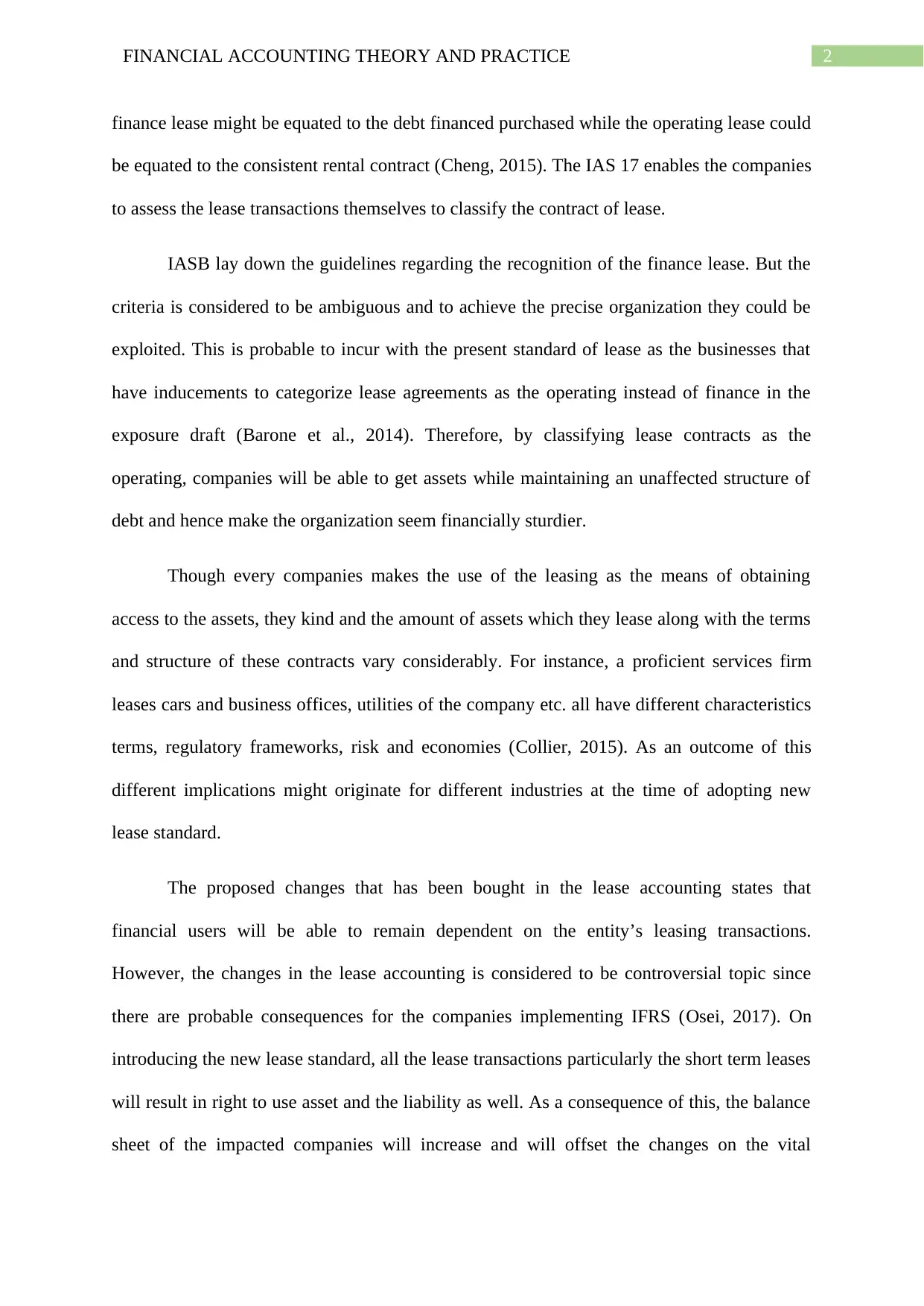
2FINANCIAL ACCOUNTING THEORY AND PRACTICE
finance lease might be equated to the debt financed purchased while the operating lease could
be equated to the consistent rental contract (Cheng, 2015). The IAS 17 enables the companies
to assess the lease transactions themselves to classify the contract of lease.
IASB lay down the guidelines regarding the recognition of the finance lease. But the
criteria is considered to be ambiguous and to achieve the precise organization they could be
exploited. This is probable to incur with the present standard of lease as the businesses that
have inducements to categorize lease agreements as the operating instead of finance in the
exposure draft (Barone et al., 2014). Therefore, by classifying lease contracts as the
operating, companies will be able to get assets while maintaining an unaffected structure of
debt and hence make the organization seem financially sturdier.
Though every companies makes the use of the leasing as the means of obtaining
access to the assets, they kind and the amount of assets which they lease along with the terms
and structure of these contracts vary considerably. For instance, a proficient services firm
leases cars and business offices, utilities of the company etc. all have different characteristics
terms, regulatory frameworks, risk and economies (Collier, 2015). As an outcome of this
different implications might originate for different industries at the time of adopting new
lease standard.
The proposed changes that has been bought in the lease accounting states that
financial users will be able to remain dependent on the entity’s leasing transactions.
However, the changes in the lease accounting is considered to be controversial topic since
there are probable consequences for the companies implementing IFRS (Osei, 2017). On
introducing the new lease standard, all the lease transactions particularly the short term leases
will result in right to use asset and the liability as well. As a consequence of this, the balance
sheet of the impacted companies will increase and will offset the changes on the vital
finance lease might be equated to the debt financed purchased while the operating lease could
be equated to the consistent rental contract (Cheng, 2015). The IAS 17 enables the companies
to assess the lease transactions themselves to classify the contract of lease.
IASB lay down the guidelines regarding the recognition of the finance lease. But the
criteria is considered to be ambiguous and to achieve the precise organization they could be
exploited. This is probable to incur with the present standard of lease as the businesses that
have inducements to categorize lease agreements as the operating instead of finance in the
exposure draft (Barone et al., 2014). Therefore, by classifying lease contracts as the
operating, companies will be able to get assets while maintaining an unaffected structure of
debt and hence make the organization seem financially sturdier.
Though every companies makes the use of the leasing as the means of obtaining
access to the assets, they kind and the amount of assets which they lease along with the terms
and structure of these contracts vary considerably. For instance, a proficient services firm
leases cars and business offices, utilities of the company etc. all have different characteristics
terms, regulatory frameworks, risk and economies (Collier, 2015). As an outcome of this
different implications might originate for different industries at the time of adopting new
lease standard.
The proposed changes that has been bought in the lease accounting states that
financial users will be able to remain dependent on the entity’s leasing transactions.
However, the changes in the lease accounting is considered to be controversial topic since
there are probable consequences for the companies implementing IFRS (Osei, 2017). On
introducing the new lease standard, all the lease transactions particularly the short term leases
will result in right to use asset and the liability as well. As a consequence of this, the balance
sheet of the impacted companies will increase and will offset the changes on the vital
⊘ This is a preview!⊘
Do you want full access?
Subscribe today to unlock all pages.

Trusted by 1+ million students worldwide
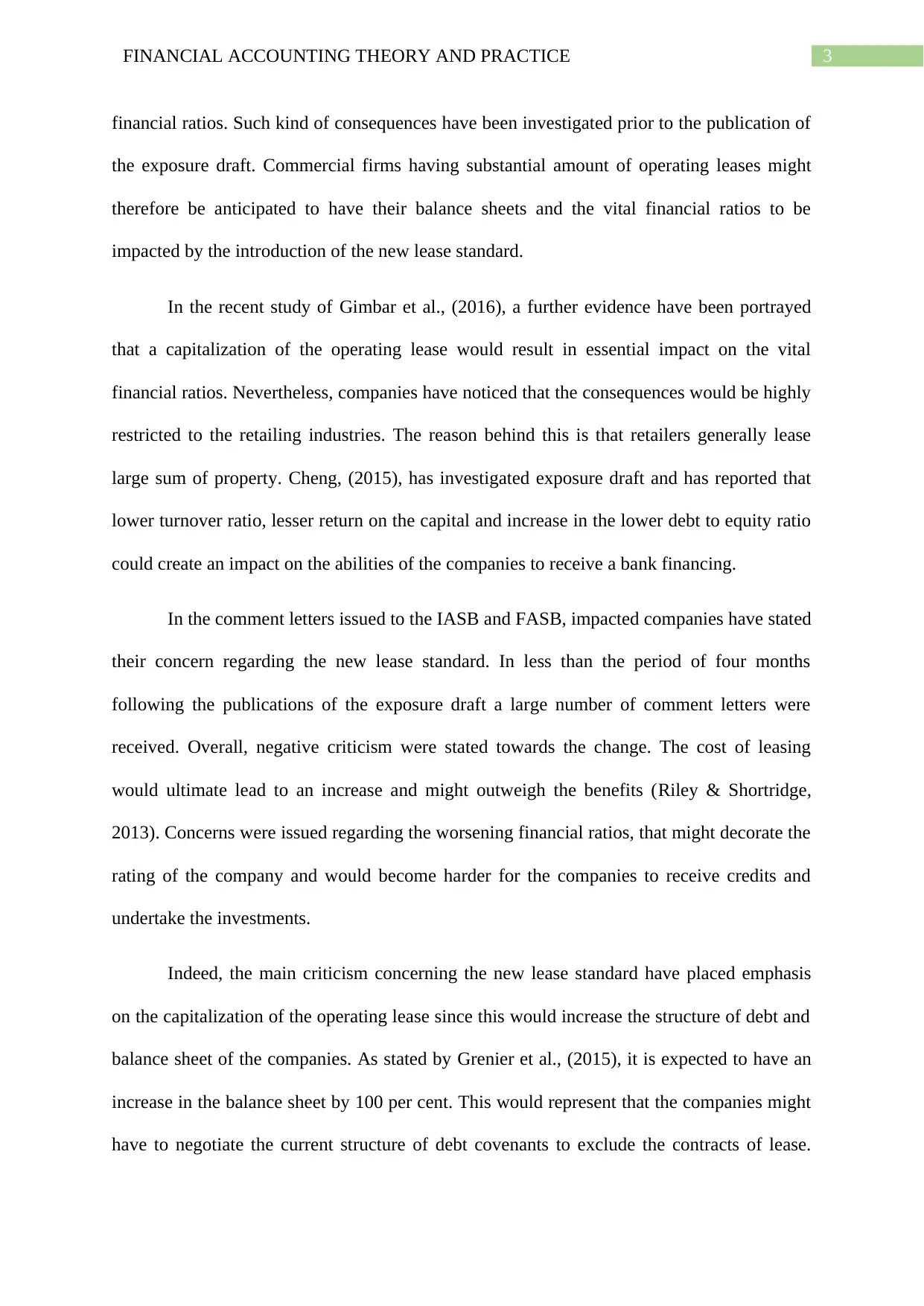
3FINANCIAL ACCOUNTING THEORY AND PRACTICE
financial ratios. Such kind of consequences have been investigated prior to the publication of
the exposure draft. Commercial firms having substantial amount of operating leases might
therefore be anticipated to have their balance sheets and the vital financial ratios to be
impacted by the introduction of the new lease standard.
In the recent study of Gimbar et al., (2016), a further evidence have been portrayed
that a capitalization of the operating lease would result in essential impact on the vital
financial ratios. Nevertheless, companies have noticed that the consequences would be highly
restricted to the retailing industries. The reason behind this is that retailers generally lease
large sum of property. Cheng, (2015), has investigated exposure draft and has reported that
lower turnover ratio, lesser return on the capital and increase in the lower debt to equity ratio
could create an impact on the abilities of the companies to receive a bank financing.
In the comment letters issued to the IASB and FASB, impacted companies have stated
their concern regarding the new lease standard. In less than the period of four months
following the publications of the exposure draft a large number of comment letters were
received. Overall, negative criticism were stated towards the change. The cost of leasing
would ultimate lead to an increase and might outweigh the benefits (Riley & Shortridge,
2013). Concerns were issued regarding the worsening financial ratios, that might decorate the
rating of the company and would become harder for the companies to receive credits and
undertake the investments.
Indeed, the main criticism concerning the new lease standard have placed emphasis
on the capitalization of the operating lease since this would increase the structure of debt and
balance sheet of the companies. As stated by Grenier et al., (2015), it is expected to have an
increase in the balance sheet by 100 per cent. This would represent that the companies might
have to negotiate the current structure of debt covenants to exclude the contracts of lease.
financial ratios. Such kind of consequences have been investigated prior to the publication of
the exposure draft. Commercial firms having substantial amount of operating leases might
therefore be anticipated to have their balance sheets and the vital financial ratios to be
impacted by the introduction of the new lease standard.
In the recent study of Gimbar et al., (2016), a further evidence have been portrayed
that a capitalization of the operating lease would result in essential impact on the vital
financial ratios. Nevertheless, companies have noticed that the consequences would be highly
restricted to the retailing industries. The reason behind this is that retailers generally lease
large sum of property. Cheng, (2015), has investigated exposure draft and has reported that
lower turnover ratio, lesser return on the capital and increase in the lower debt to equity ratio
could create an impact on the abilities of the companies to receive a bank financing.
In the comment letters issued to the IASB and FASB, impacted companies have stated
their concern regarding the new lease standard. In less than the period of four months
following the publications of the exposure draft a large number of comment letters were
received. Overall, negative criticism were stated towards the change. The cost of leasing
would ultimate lead to an increase and might outweigh the benefits (Riley & Shortridge,
2013). Concerns were issued regarding the worsening financial ratios, that might decorate the
rating of the company and would become harder for the companies to receive credits and
undertake the investments.
Indeed, the main criticism concerning the new lease standard have placed emphasis
on the capitalization of the operating lease since this would increase the structure of debt and
balance sheet of the companies. As stated by Grenier et al., (2015), it is expected to have an
increase in the balance sheet by 100 per cent. This would represent that the companies might
have to negotiate the current structure of debt covenants to exclude the contracts of lease.
Paraphrase This Document
Need a fresh take? Get an instant paraphrase of this document with our AI Paraphraser
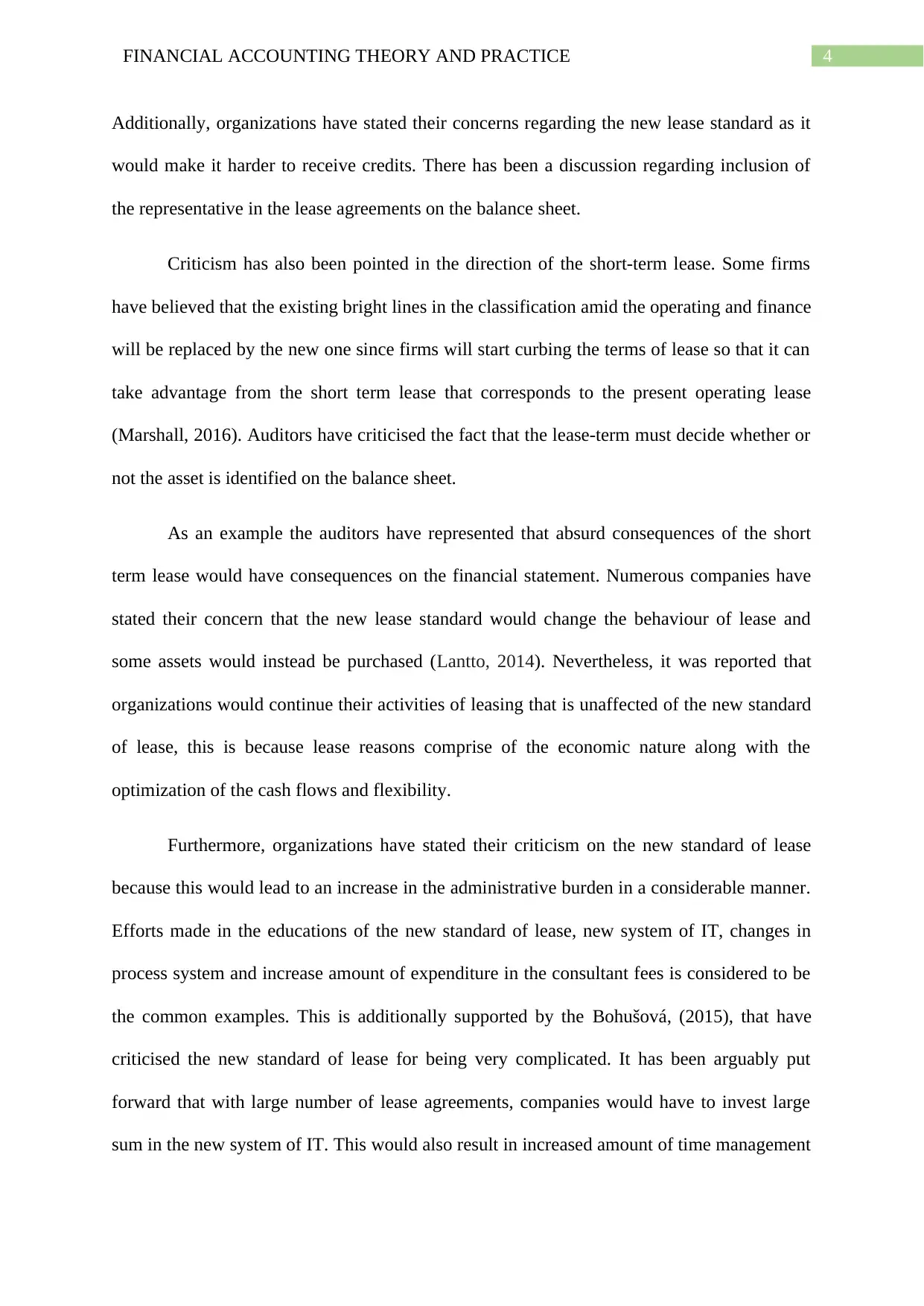
4FINANCIAL ACCOUNTING THEORY AND PRACTICE
Additionally, organizations have stated their concerns regarding the new lease standard as it
would make it harder to receive credits. There has been a discussion regarding inclusion of
the representative in the lease agreements on the balance sheet.
Criticism has also been pointed in the direction of the short-term lease. Some firms
have believed that the existing bright lines in the classification amid the operating and finance
will be replaced by the new one since firms will start curbing the terms of lease so that it can
take advantage from the short term lease that corresponds to the present operating lease
(Marshall, 2016). Auditors have criticised the fact that the lease-term must decide whether or
not the asset is identified on the balance sheet.
As an example the auditors have represented that absurd consequences of the short
term lease would have consequences on the financial statement. Numerous companies have
stated their concern that the new lease standard would change the behaviour of lease and
some assets would instead be purchased (Lantto, 2014). Nevertheless, it was reported that
organizations would continue their activities of leasing that is unaffected of the new standard
of lease, this is because lease reasons comprise of the economic nature along with the
optimization of the cash flows and flexibility.
Furthermore, organizations have stated their criticism on the new standard of lease
because this would lead to an increase in the administrative burden in a considerable manner.
Efforts made in the educations of the new standard of lease, new system of IT, changes in
process system and increase amount of expenditure in the consultant fees is considered to be
the common examples. This is additionally supported by the Bohušová, (2015), that have
criticised the new standard of lease for being very complicated. It has been arguably put
forward that with large number of lease agreements, companies would have to invest large
sum in the new system of IT. This would also result in increased amount of time management
Additionally, organizations have stated their concerns regarding the new lease standard as it
would make it harder to receive credits. There has been a discussion regarding inclusion of
the representative in the lease agreements on the balance sheet.
Criticism has also been pointed in the direction of the short-term lease. Some firms
have believed that the existing bright lines in the classification amid the operating and finance
will be replaced by the new one since firms will start curbing the terms of lease so that it can
take advantage from the short term lease that corresponds to the present operating lease
(Marshall, 2016). Auditors have criticised the fact that the lease-term must decide whether or
not the asset is identified on the balance sheet.
As an example the auditors have represented that absurd consequences of the short
term lease would have consequences on the financial statement. Numerous companies have
stated their concern that the new lease standard would change the behaviour of lease and
some assets would instead be purchased (Lantto, 2014). Nevertheless, it was reported that
organizations would continue their activities of leasing that is unaffected of the new standard
of lease, this is because lease reasons comprise of the economic nature along with the
optimization of the cash flows and flexibility.
Furthermore, organizations have stated their criticism on the new standard of lease
because this would lead to an increase in the administrative burden in a considerable manner.
Efforts made in the educations of the new standard of lease, new system of IT, changes in
process system and increase amount of expenditure in the consultant fees is considered to be
the common examples. This is additionally supported by the Bohušová, (2015), that have
criticised the new standard of lease for being very complicated. It has been arguably put
forward that with large number of lease agreements, companies would have to invest large
sum in the new system of IT. This would also result in increased amount of time management
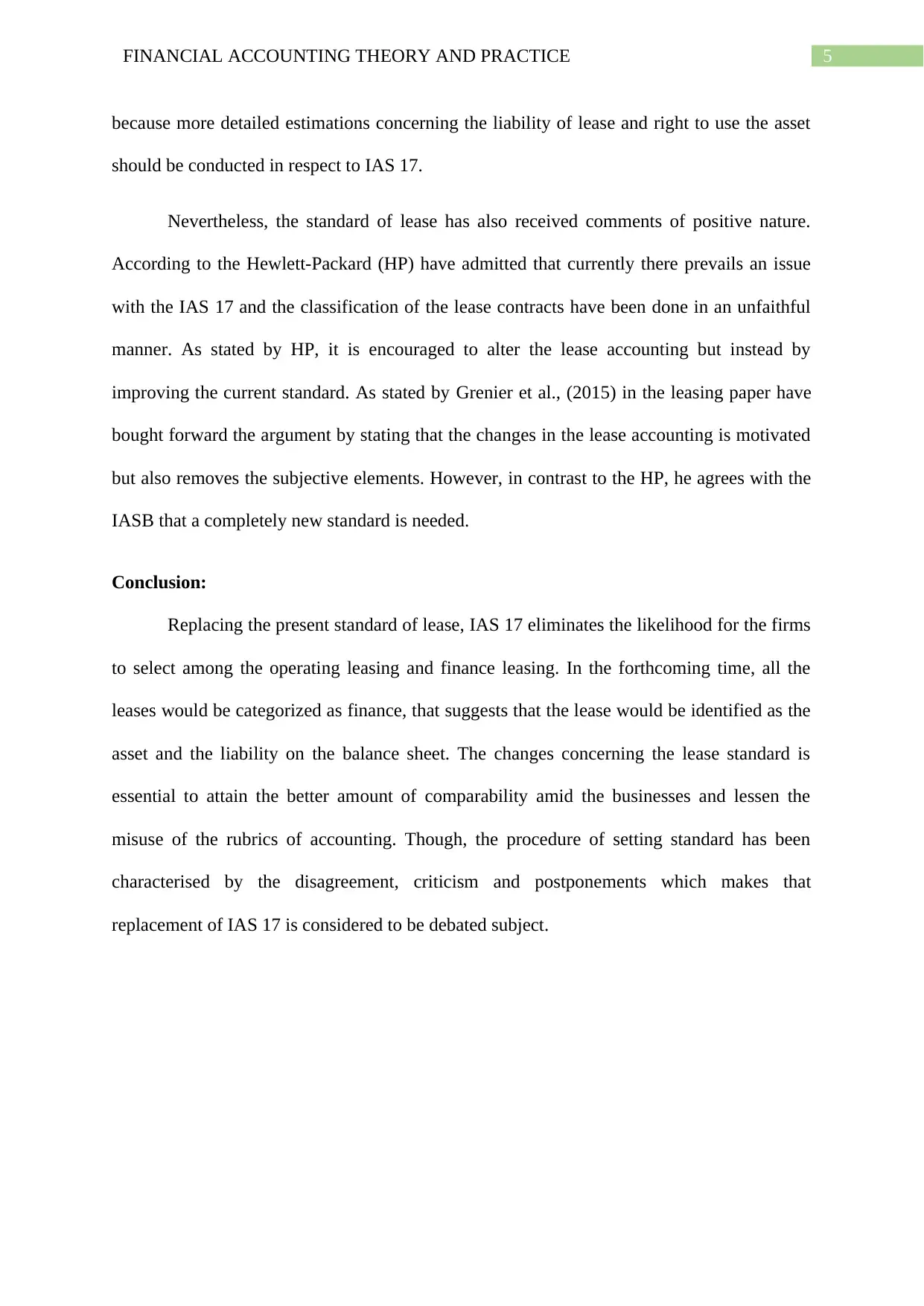
5FINANCIAL ACCOUNTING THEORY AND PRACTICE
because more detailed estimations concerning the liability of lease and right to use the asset
should be conducted in respect to IAS 17.
Nevertheless, the standard of lease has also received comments of positive nature.
According to the Hewlett-Packard (HP) have admitted that currently there prevails an issue
with the IAS 17 and the classification of the lease contracts have been done in an unfaithful
manner. As stated by HP, it is encouraged to alter the lease accounting but instead by
improving the current standard. As stated by Grenier et al., (2015) in the leasing paper have
bought forward the argument by stating that the changes in the lease accounting is motivated
but also removes the subjective elements. However, in contrast to the HP, he agrees with the
IASB that a completely new standard is needed.
Conclusion:
Replacing the present standard of lease, IAS 17 eliminates the likelihood for the firms
to select among the operating leasing and finance leasing. In the forthcoming time, all the
leases would be categorized as finance, that suggests that the lease would be identified as the
asset and the liability on the balance sheet. The changes concerning the lease standard is
essential to attain the better amount of comparability amid the businesses and lessen the
misuse of the rubrics of accounting. Though, the procedure of setting standard has been
characterised by the disagreement, criticism and postponements which makes that
replacement of IAS 17 is considered to be debated subject.
because more detailed estimations concerning the liability of lease and right to use the asset
should be conducted in respect to IAS 17.
Nevertheless, the standard of lease has also received comments of positive nature.
According to the Hewlett-Packard (HP) have admitted that currently there prevails an issue
with the IAS 17 and the classification of the lease contracts have been done in an unfaithful
manner. As stated by HP, it is encouraged to alter the lease accounting but instead by
improving the current standard. As stated by Grenier et al., (2015) in the leasing paper have
bought forward the argument by stating that the changes in the lease accounting is motivated
but also removes the subjective elements. However, in contrast to the HP, he agrees with the
IASB that a completely new standard is needed.
Conclusion:
Replacing the present standard of lease, IAS 17 eliminates the likelihood for the firms
to select among the operating leasing and finance leasing. In the forthcoming time, all the
leases would be categorized as finance, that suggests that the lease would be identified as the
asset and the liability on the balance sheet. The changes concerning the lease standard is
essential to attain the better amount of comparability amid the businesses and lessen the
misuse of the rubrics of accounting. Though, the procedure of setting standard has been
characterised by the disagreement, criticism and postponements which makes that
replacement of IAS 17 is considered to be debated subject.
⊘ This is a preview!⊘
Do you want full access?
Subscribe today to unlock all pages.

Trusted by 1+ million students worldwide
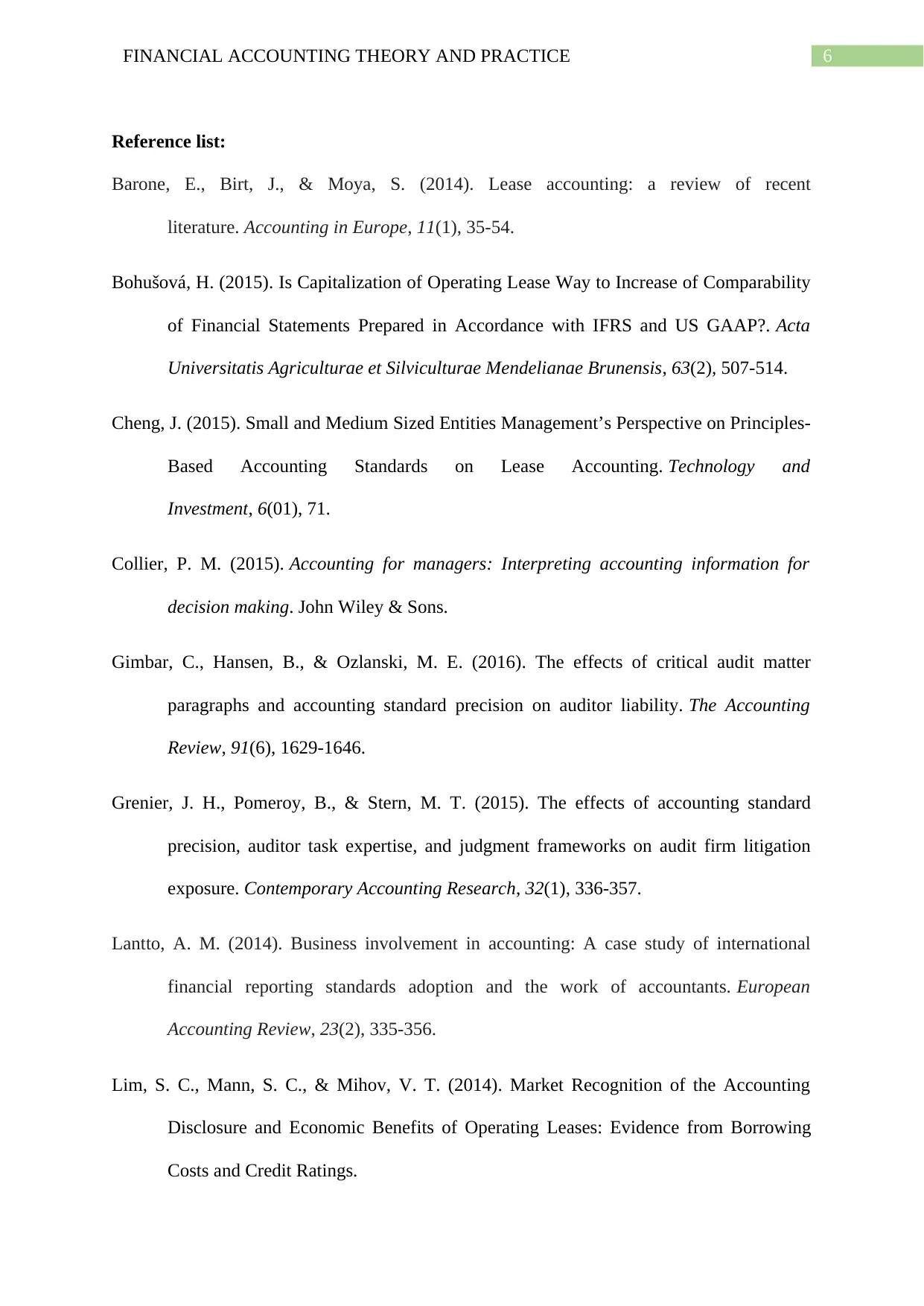
6FINANCIAL ACCOUNTING THEORY AND PRACTICE
Reference list:
Barone, E., Birt, J., & Moya, S. (2014). Lease accounting: a review of recent
literature. Accounting in Europe, 11(1), 35-54.
Bohušová, H. (2015). Is Capitalization of Operating Lease Way to Increase of Comparability
of Financial Statements Prepared in Accordance with IFRS and US GAAP?. Acta
Universitatis Agriculturae et Silviculturae Mendelianae Brunensis, 63(2), 507-514.
Cheng, J. (2015). Small and Medium Sized Entities Management’s Perspective on Principles-
Based Accounting Standards on Lease Accounting. Technology and
Investment, 6(01), 71.
Collier, P. M. (2015). Accounting for managers: Interpreting accounting information for
decision making. John Wiley & Sons.
Gimbar, C., Hansen, B., & Ozlanski, M. E. (2016). The effects of critical audit matter
paragraphs and accounting standard precision on auditor liability. The Accounting
Review, 91(6), 1629-1646.
Grenier, J. H., Pomeroy, B., & Stern, M. T. (2015). The effects of accounting standard
precision, auditor task expertise, and judgment frameworks on audit firm litigation
exposure. Contemporary Accounting Research, 32(1), 336-357.
Lantto, A. M. (2014). Business involvement in accounting: A case study of international
financial reporting standards adoption and the work of accountants. European
Accounting Review, 23(2), 335-356.
Lim, S. C., Mann, S. C., & Mihov, V. T. (2014). Market Recognition of the Accounting
Disclosure and Economic Benefits of Operating Leases: Evidence from Borrowing
Costs and Credit Ratings.
Reference list:
Barone, E., Birt, J., & Moya, S. (2014). Lease accounting: a review of recent
literature. Accounting in Europe, 11(1), 35-54.
Bohušová, H. (2015). Is Capitalization of Operating Lease Way to Increase of Comparability
of Financial Statements Prepared in Accordance with IFRS and US GAAP?. Acta
Universitatis Agriculturae et Silviculturae Mendelianae Brunensis, 63(2), 507-514.
Cheng, J. (2015). Small and Medium Sized Entities Management’s Perspective on Principles-
Based Accounting Standards on Lease Accounting. Technology and
Investment, 6(01), 71.
Collier, P. M. (2015). Accounting for managers: Interpreting accounting information for
decision making. John Wiley & Sons.
Gimbar, C., Hansen, B., & Ozlanski, M. E. (2016). The effects of critical audit matter
paragraphs and accounting standard precision on auditor liability. The Accounting
Review, 91(6), 1629-1646.
Grenier, J. H., Pomeroy, B., & Stern, M. T. (2015). The effects of accounting standard
precision, auditor task expertise, and judgment frameworks on audit firm litigation
exposure. Contemporary Accounting Research, 32(1), 336-357.
Lantto, A. M. (2014). Business involvement in accounting: A case study of international
financial reporting standards adoption and the work of accountants. European
Accounting Review, 23(2), 335-356.
Lim, S. C., Mann, S. C., & Mihov, V. T. (2014). Market Recognition of the Accounting
Disclosure and Economic Benefits of Operating Leases: Evidence from Borrowing
Costs and Credit Ratings.
Paraphrase This Document
Need a fresh take? Get an instant paraphrase of this document with our AI Paraphraser
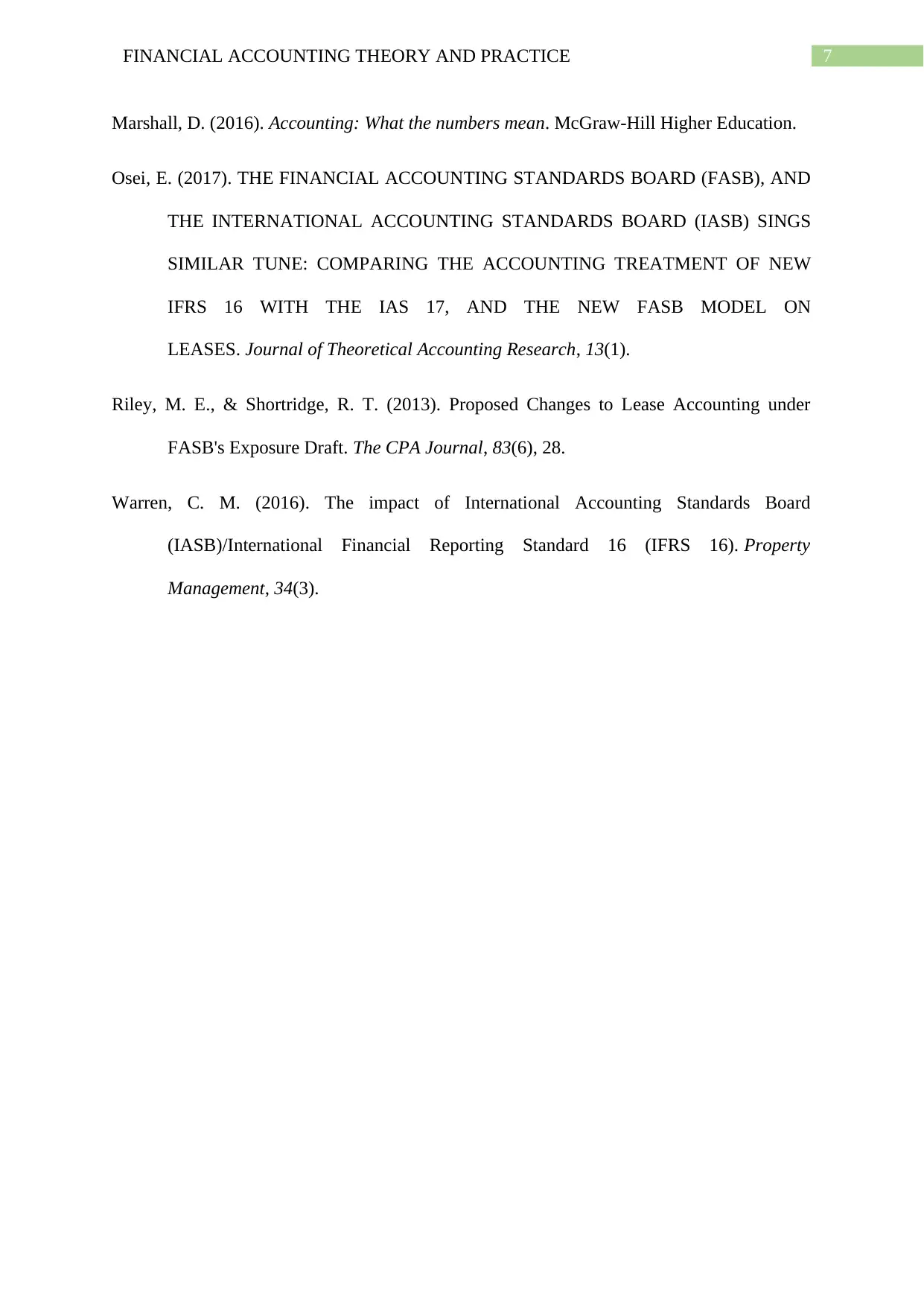
7FINANCIAL ACCOUNTING THEORY AND PRACTICE
Marshall, D. (2016). Accounting: What the numbers mean. McGraw-Hill Higher Education.
Osei, E. (2017). THE FINANCIAL ACCOUNTING STANDARDS BOARD (FASB), AND
THE INTERNATIONAL ACCOUNTING STANDARDS BOARD (IASB) SINGS
SIMILAR TUNE: COMPARING THE ACCOUNTING TREATMENT OF NEW
IFRS 16 WITH THE IAS 17, AND THE NEW FASB MODEL ON
LEASES. Journal of Theoretical Accounting Research, 13(1).
Riley, M. E., & Shortridge, R. T. (2013). Proposed Changes to Lease Accounting under
FASB's Exposure Draft. The CPA Journal, 83(6), 28.
Warren, C. M. (2016). The impact of International Accounting Standards Board
(IASB)/International Financial Reporting Standard 16 (IFRS 16). Property
Management, 34(3).
Marshall, D. (2016). Accounting: What the numbers mean. McGraw-Hill Higher Education.
Osei, E. (2017). THE FINANCIAL ACCOUNTING STANDARDS BOARD (FASB), AND
THE INTERNATIONAL ACCOUNTING STANDARDS BOARD (IASB) SINGS
SIMILAR TUNE: COMPARING THE ACCOUNTING TREATMENT OF NEW
IFRS 16 WITH THE IAS 17, AND THE NEW FASB MODEL ON
LEASES. Journal of Theoretical Accounting Research, 13(1).
Riley, M. E., & Shortridge, R. T. (2013). Proposed Changes to Lease Accounting under
FASB's Exposure Draft. The CPA Journal, 83(6), 28.
Warren, C. M. (2016). The impact of International Accounting Standards Board
(IASB)/International Financial Reporting Standard 16 (IFRS 16). Property
Management, 34(3).
1 out of 8
Related Documents
Your All-in-One AI-Powered Toolkit for Academic Success.
+13062052269
info@desklib.com
Available 24*7 on WhatsApp / Email
![[object Object]](/_next/static/media/star-bottom.7253800d.svg)
Unlock your academic potential
Copyright © 2020–2025 A2Z Services. All Rights Reserved. Developed and managed by ZUCOL.





